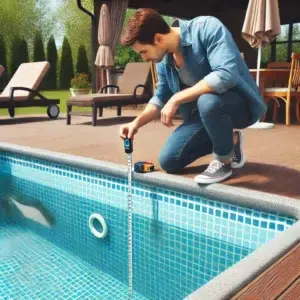The Difference Between Pressure Testing and Electronic Leak Detection
When a pool in New Jersey starts losing water, many homeowners quickly search for the cause but are unsure which testing method to request. The two most common techniques—pressure testing and electronic leak detection—sound similar but serve very different purposes. Understanding how they differ is the key to choosing the correct diagnostic approach and scheduling the most efficient pool leak repair. This detailed guide from Pool Patcher® explains what each method does, when it’s needed, and how both work together to protect your investment.
Why Accurate Leak Testing Matters
Every inground pool system consists of two major components: the structure (vinyl liner, plaster, or fiberglass) and the plumbing (underground pipes that circulate water). A structural leak behaves differently from a pipe leak, and using the wrong test wastes time and money. Choosing the right diagnostic ensures that your pool leak repair targets the exact problem the first time—whether it’s a hidden crack in the return line or a separation around the skimmer throat.
What Pressure Testing Actually Does
Pressure testing verifies whether your underground pool plumbing holds pressure properly. Each line—returns, skimmers, main drain, and cleaner—is isolated and sealed. Water or air is then injected into the line while a gauge is monitored for pressure loss. A drop on the gauge confirms that a leak exists somewhere along that particular line.
This mechanical test is perfect for detecting plumbing-related issues such as:
- Cracked or collapsed underground pipes caused by soil movement
- Loose fittings or broken couplings near returns and skimmers
- Freeze-related pipe splits common in Monmouth County winters
- Leaks beneath decks or patios where excavation would otherwise be blind
Pressure testing is a yes-or-no method—it confirms the presence of a leak but does not reveal the exact spot. Once a line fails the test, the next step is pinpointing its location with electronic tools.
How Electronic Leak Detection Works
Electronic leak detection is a precision process using advanced sensors to locate the exact point of water loss. The technique introduces a low-voltage signal into the pool water and listens for breaks in current flow where water escapes through cracks or separations. The equipment detects sound and electrical changes that lead directly to the leak’s origin—often within inches.
Electronic detection is highly effective for:
- Pinhole liner leaks and seam separations
- Hairline cracks in plaster or gunite
- Hidden plumbing leaks after pressure loss is confirmed
- Small leaks that aren’t visible but still cause measurable water loss
This method is completely non-invasive and doesn’t require draining the pool. For Monmouth County homeowners, where pools are often surrounded by finished patios or landscaped yards, this technology prevents unnecessary digging and preserves the property’s appearance.
When to Use Pressure Testing vs. Electronic Detection
Each method serves a specific stage of diagnosis:
- Pressure testing should be your first step if you suspect underground plumbing damage or see air bubbles in the returns.
- Electronic leak detection should follow when you need to pinpoint the leak’s exact position—either in the pool shell or within a pipe previously confirmed as leaking.
At Pool Patcher®, both tests can be performed during a single visit, but they are billed separately unless included in a full inspection package. This transparency ensures homeowners pay only for the precise diagnostics their pool requires.
Why Both Methods Are Important for Pool Leak Repair
Pressure testing and electronic leak detection complement each other. One identifies whether a problem exists; the other determines where it is. Relying on one alone can leave uncertainty and result in partial repairs. Combining both allows technicians to locate every leak before starting any excavation or liner patching, ensuring faster, cleaner, and guaranteed results.
Pool Patcher® pressure testing equipment uses calibrated gauges and high-precision plugs to verify line integrity. Our electronic systems use hydrophones, ground microphones, and frequency-specific amplifiers designed exclusively for pool environments. Together, these technologies eliminate guesswork and reduce total repair costs.
Common Myths About Leak Testing
One widespread myth is that electronic detection replaces pressure testing. In truth, electronic equipment can’t test for pressure retention—it only detects leak locations after pressure confirms a loss. Another misconception is that these tests automatically include repairs. In professional diagnostics, testing and repair are separate stages: testing verifies the problem; repair resolves it. Pool Patcher® provides detailed reports so customers understand exactly what was found before any repair work begins.
Choosing the Right Professionals in Monmouth County
Not every company offering pool service in Monmouth County specializes in true leak diagnostics. Many rely on scuba divers or simple dye tests, which are insufficient for underground leaks. Pool Patcher® focuses exclusively on non-scuba electronic testing and precise pool leak repair for residential inground pools. Our methods locate leaks without draining the pool or destroying finished surfaces, and every result comes with our guarantee.
Signs It’s Time for a Professional Test
If you notice any of these signs, it’s time to schedule diagnostic testing:
- Water loss greater than ¼ inch per day
- Air in the returns or gurgling sounds at the skimmer
- Persistent wet soil near the equipment pad or deck
- Water level stabilizing at the same height week after week
These symptoms suggest either a structural or plumbing leak, and professional confirmation is the only way to know which it is. Pressure testing and electronic detection together give definitive answers.
Maintaining Leak-Free Performance
After completing a repair, maintaining proper water chemistry and checking fittings annually prevents future problems. Seasonal freezing and ground movement can cause small shifts in plumbing connections. Regular inspections—especially after harsh Monmouth County winters—protect your pool from recurring water loss and unnecessary damage.
Schedule a Leak Evaluation Today
If you’re unsure which test your pool needs, our team can guide you. Visit our pool leak detection page or contact Pool Patcher® to schedule service anywhere in Monmouth County and surrounding areas. We provide set-fee pricing, same-week scheduling during peak season, and a results-backed guarantee.




